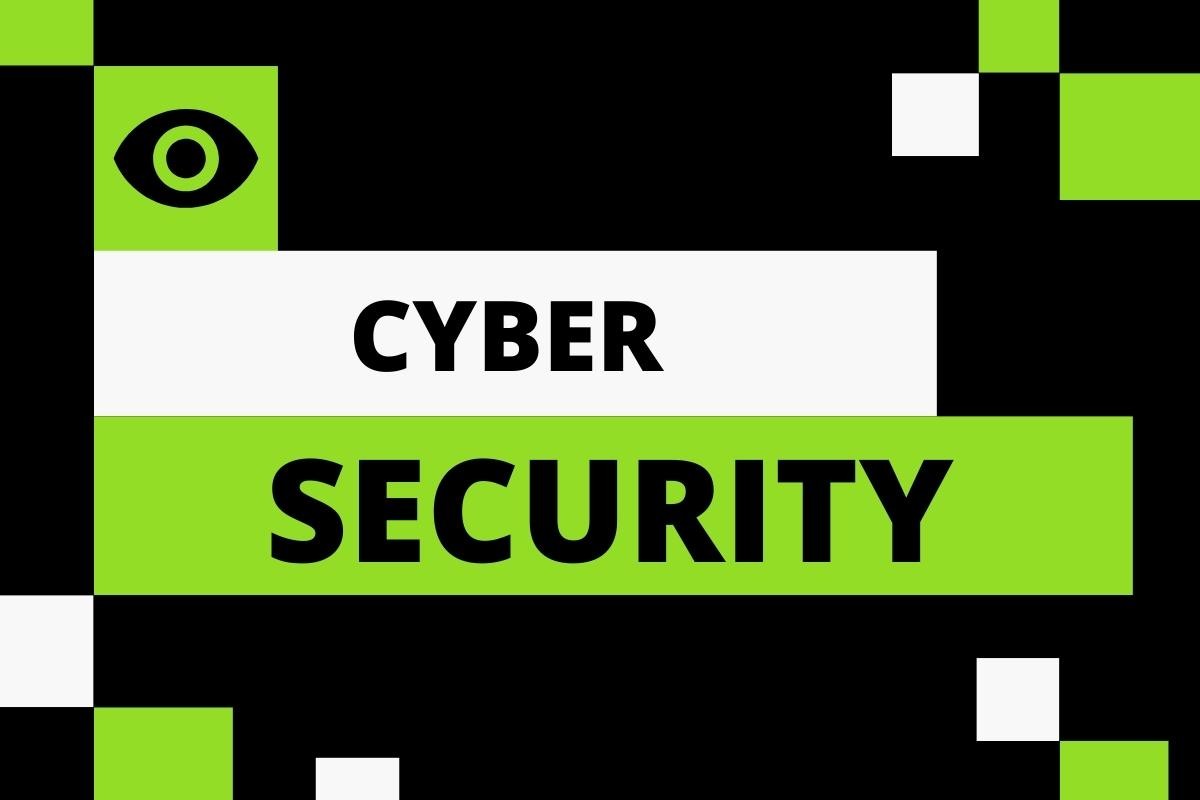
What Is Cyber Security, and Why Do You Need It?
In an age where digital systems are becoming increasingly prevalent and interconnected, cyber security has become a significant concern for individuals and organizations.
Cyber security protects networks, systems, programs, devices, and data from malicious attacks or unauthorized access. It includes a variety of measures such as firewalls, encryption technologies, and user authentication protocols that protect against cyber threats like malware, phishing scams, or denial of service (DoS) attacks.
As more businesses move their operations online and rely heavily on digital infrastructure to conduct business activities, the importance of cyber security cannot be overstated.
This article will provide an overview of cyber security, its key components, and why everyone needs to understand the risks associated with being vulnerable to cyber-attacks.
What’s the difference between a DoS attack and a regular attack? A DoS has more denial.
What is cyber security, and what are its key components?
Cyber security is a broad field that encompasses the processes and technologies used to protect computers, networks, programs, and data from unauthorized access or attacks. It involves a combination of preventive measures such as firewalls and encryption, detection systems such as intrusion detection and prevention systems (IDS/IPS), and response procedures for dealing with cyber incidents.
At its core, cyber security protects systems, data, and networks from unauthorized access or manipulation by malicious actors.
The key components of cyber security include:
Firewalls are hardware or software solutions designed to control network traffic that passes between a network and the public internet. They can restrict certain activities like downloading executable files or accessing certain websites.
Encryption – This is the process of encoding data so that those with the correct key can only decrypt it. It prevents unauthorized access to sensitive information and helps protect data in transit and when it's stored on a computer or server.
Intrusion detection systems (IDS) – These are designed to detect and alert users to malicious activities on their network. They can be either signature-based, which looks for known attack patterns, or anomaly-based, which looks for unusual traffic on the network.
User authentication protocols ensure that only authorized users can access resources. Examples include two-factor authentication, which requires users to enter a code sent to their mobile device and provide their username and password.
How can you be vulnerable to cyber-attacks, and what are the risks involved?
Cyber attacks often involve:
Exploiting weaknesses in systems or software.
Using social engineering techniques like phishing emails or malicious websites.
Simply guessing weak passwords.
If you're using '12345' as your password, don't be surprised if someone else is guessing it too."
The risks associated with being vulnerable to cyber-attacks vary depending on the attack type and the information exposed. In some cases, attackers may gain access to confidential data such as financial records or customer information.
They may also be able to install malware on a system or use it for distributed denial of service (DDoS) attacks against other networks. Such attacks can have serious financial or reputational repercussions for organizations.
Why do you need cyber security, and what are the benefits of having it in place?
Cyber security is essential because it helps to protect data, networks, and systems from unauthorized access and malicious attacks. Implementing effective cybersecurity measures can help to prevent data breaches, reduce the risk of financial losses and protect businesses' reputations.
Implementing effective cybersecurity measures can be a business's best line of defense.
It can also help organizations comply with regulatory requirements such as GDPR or HIPAA. In addition, having a robust cybersecurity strategy can help companies improve their operational efficiency by reducing downtime caused by malware infections or other cyber-attacks.
How can you protect yourself from cyber attacks, and what should you do if you're a victim?
To protect yourself from cyber attacks, it's vital to take basic security measures such as using strong passwords, keeping software up to date, and avoiding clicking on suspicious links or downloading attachments from unknown sources.
You should also be aware of the signs of a potential attack and take steps to protect your data if you think you may have been targeted. If you are a victim of a cyber attack, the first step is to alert the authorities and contact your IT department so that they can investigate the incident and take appropriate measures.
Hackers don't stand a chance against the authorities and your IT department - sound the alarm if you're a victim of a cyber attack!
What's the future of cyber security, and how will it evolve?
As threats become more sophisticated, organizations need to stay ahead of attackers by staying abreast of new trends in cyber security. In the future, AI-powered technologies such as machine learning and natural language processing will be used to detect threats more quickly and accurately.
Additionally, organizations should continue to invest in training their employees on cybersecurity best practices so that they can identify potential risks and respond quickly when needed. Ultimately, cyber security is an ever-evolving field that requires constant vigilance to stay ahead of attackers.
Cyber security is essential to protecting your data and networks from unauthorized access or malicious attacks. By taking the necessary steps to protect yourself, you can help ensure that your organization remains secure.
It's also essential to stay informed about the latest threats and trends to keep up with attackers and ensure that your systems are protected against potential risks. With cyber security continuing to evolve, organizations must stay on top of this ever-changing landscape to remain safe and secure.
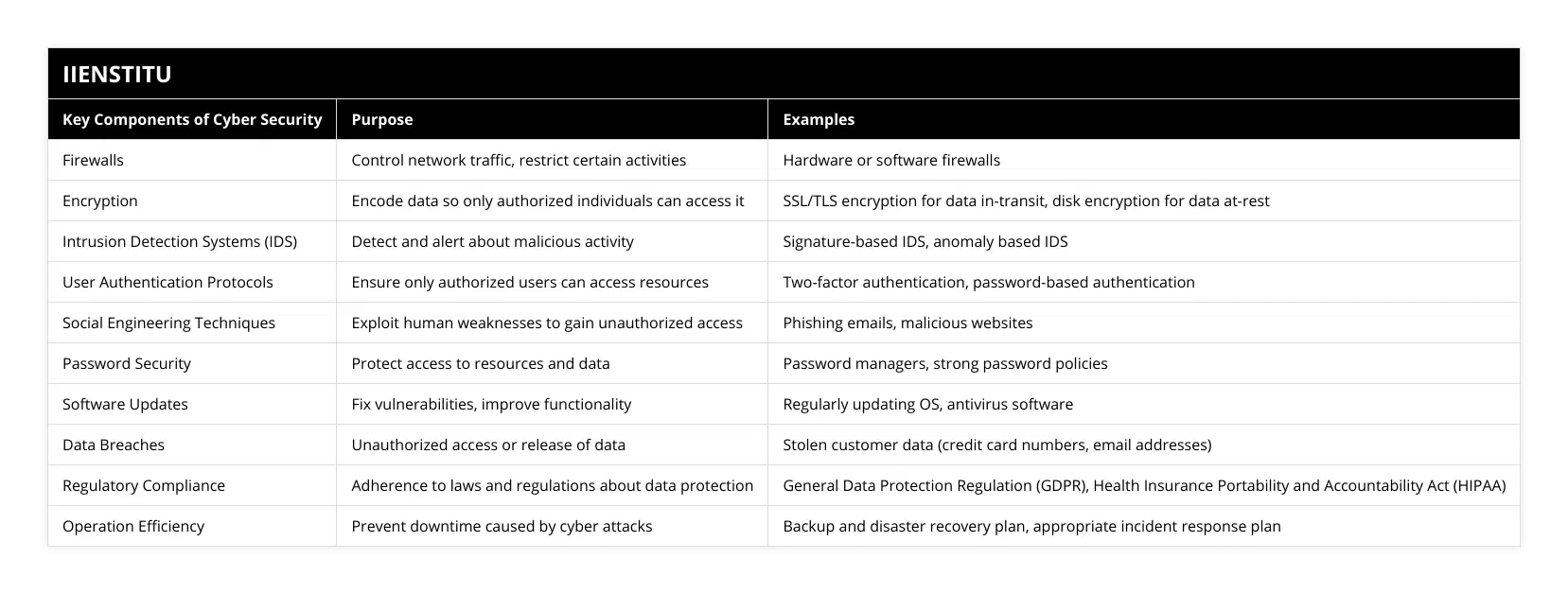
Frequently Asked Questions
What is cyber security?
Cyber security is the practice of protecting computers, networks, and programs from digital attacks. These attacks can come in many forms, such as unauthorized access by hackers to obtain confidential information or ransomware to lock users out of their systems until a ransom is paid. Cyber security measures involve implementing technologies such as firewalls or encryption and user-level best practices like strong passwords and keeping software up to date.
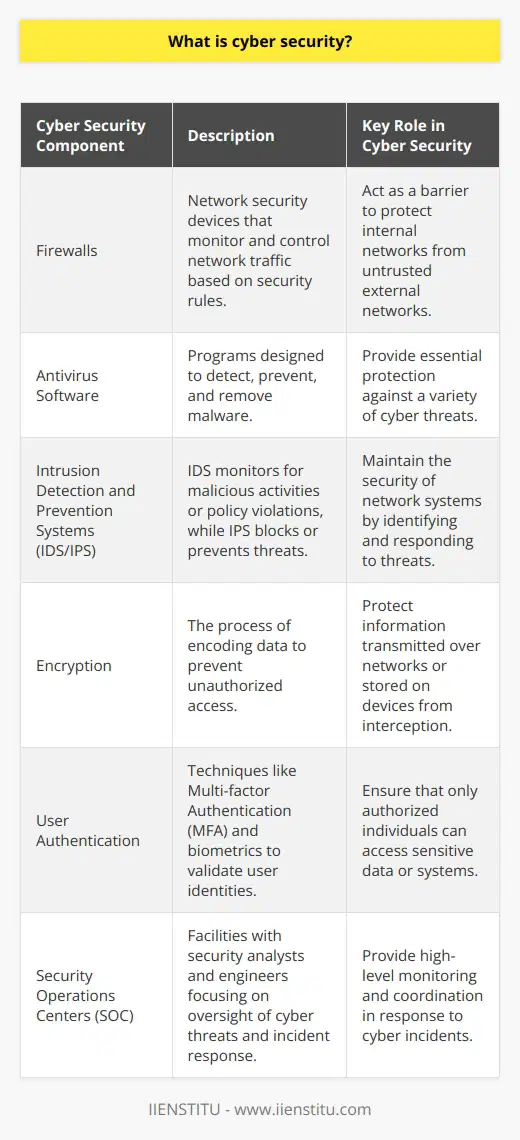
What are the risks associated with cyber-attacks?
Depending on the attack type and the information exposed, there can be various risks associated with cyber-attacks. These can range from financial losses due to stolen data or reputational damage caused by malicious activity on a system. In addition, attackers may be able to install malware on a system which could lead to further disruptions or data breaches.
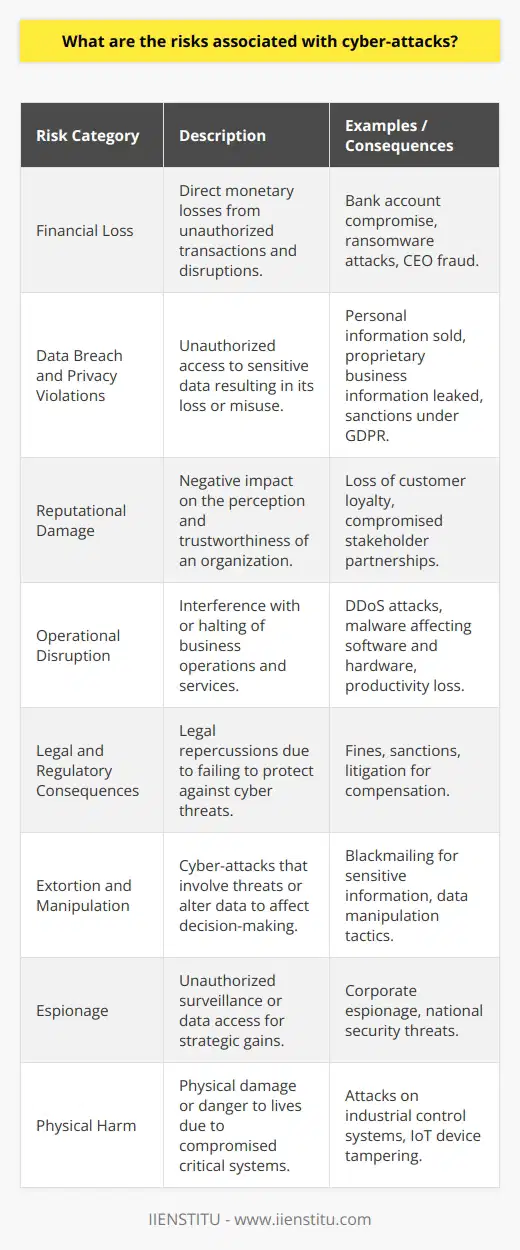
Why do I need cyber security?
Implementing effective cyber security measures can help protect your data from unauthorized access or malicious use, reduce the risk of financial losses and protect your company's reputation. Additionally, having a robust cyber security strategy in place can help companies comply with regulatory requirements such as GDPR or HIPAA and improve operational efficiency by reducing downtime caused by cyber-attacks.
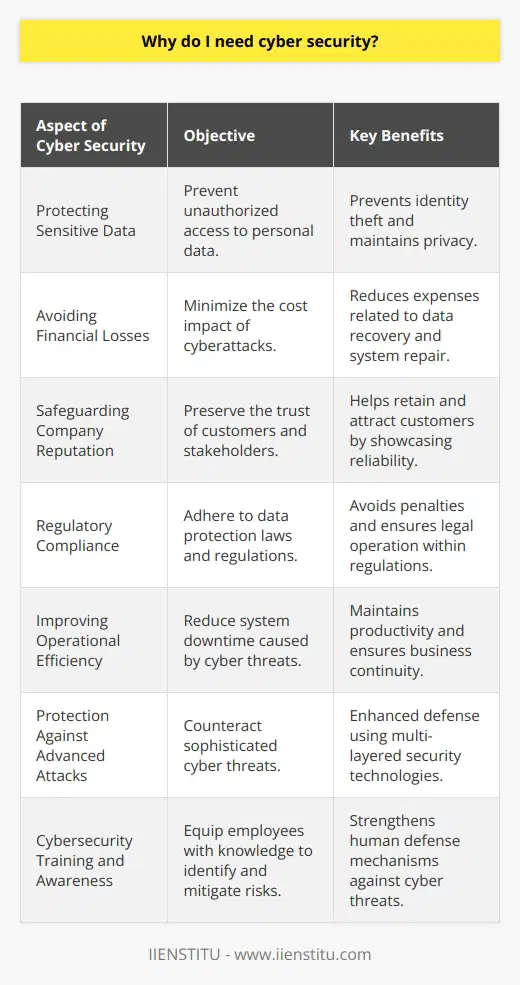
What are the best practices for protecting my organization from cyber-attacks?
Implement strong password policies and use two-factor authentication for all accounts.
Regularly patch and update all software applications.
Use firewalls, antivirus, and other security measures to protect the network from external threats.
Regularly monitor networks and systems for suspicious activity.
Train employees on cybersecurity best practices and update them regularly.
Limit access to sensitive data and systems to only those who need it.
Back up data regularly and store backups off-site.
Implement mobile device management policies.
Restrict physical access to computers and other devices.
Utilize encryption for data in transit and at rest.
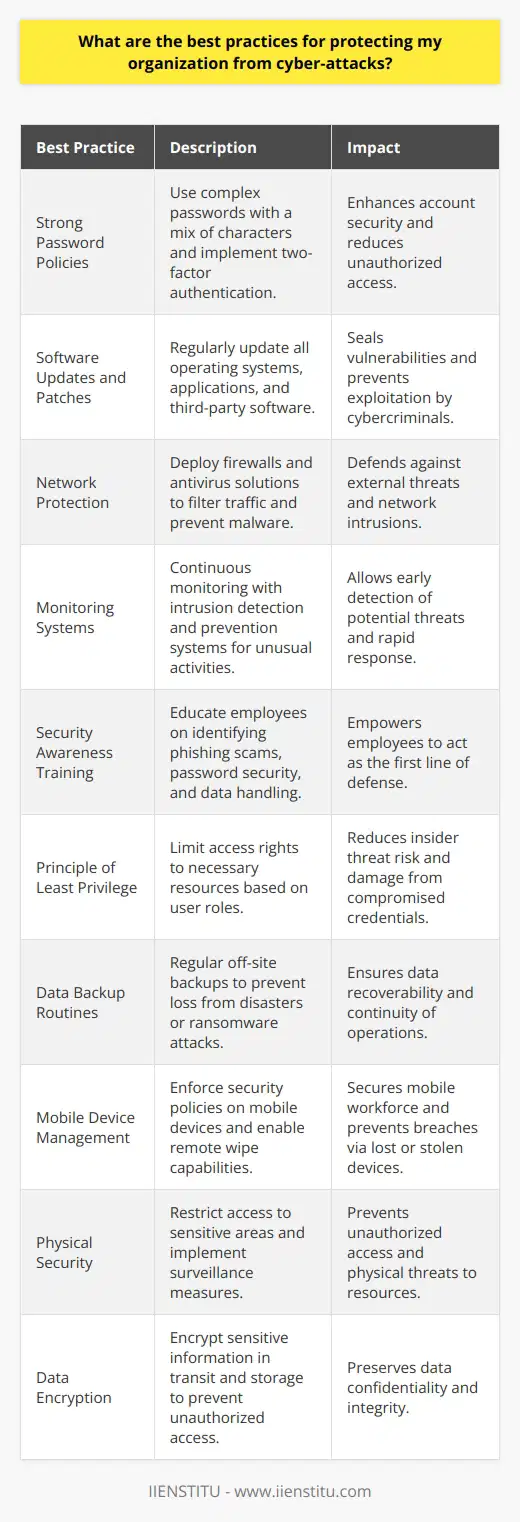
What measures can I take to ensure my personal data is secure?
Use strong passwords: Choose a strong password that is at least eight characters long, uses a combination of upper and lower case letters, numbers, and symbols.
Install antivirus software: Install and regularly update antivirus software to prevent malicious software from accessing your personal data.
Use two-factor authentication: Whenever possible, use two-factor authentication for online accounts and services. This adds an extra layer of security by requiring you to enter a code sent to your phone or email address in addition to your username and password.
Back up your data: Regularly back up your data to an external hard drive or cloud storage service to prevent data loss.
Be cautious when sharing personal data: Only share your personal data when absolutely necessary and be sure to read the privacy policies of any website or service you use.
Monitor your accounts: Regularly monitor your bank and credit card statements for any suspicious activity.

What technologies are available to help improve my organization's cyber security posture?
Endpoint Security Solutions: These solutions help protect your organization's network by providing anti-malware, firewalls, and other endpoint security features.
Data Loss Prevention (DLP) Solutions: These solutions help monitor, detect, and prevent data from leaving the organization.
Network Security Solutions: These solutions provide enhanced protection against external threats and unauthorized access.
Identity and Access Management Solutions: These solutions help you manage and control user access to sensitive data and applications.
Intrusion Detection and Prevention Solutions: These solutions help detect and prevent malicious activity on the network.
Encryption Solutions: These solutions help protect your data from unauthorized access by encrypting it.
Risk Management Solutions: These solutions help identify and mitigate potential risks and vulnerabilities.
Security Awareness Training: Security awareness training helps educate employees on cybersecurity best practices and how to recognize and respond to cyber threats.
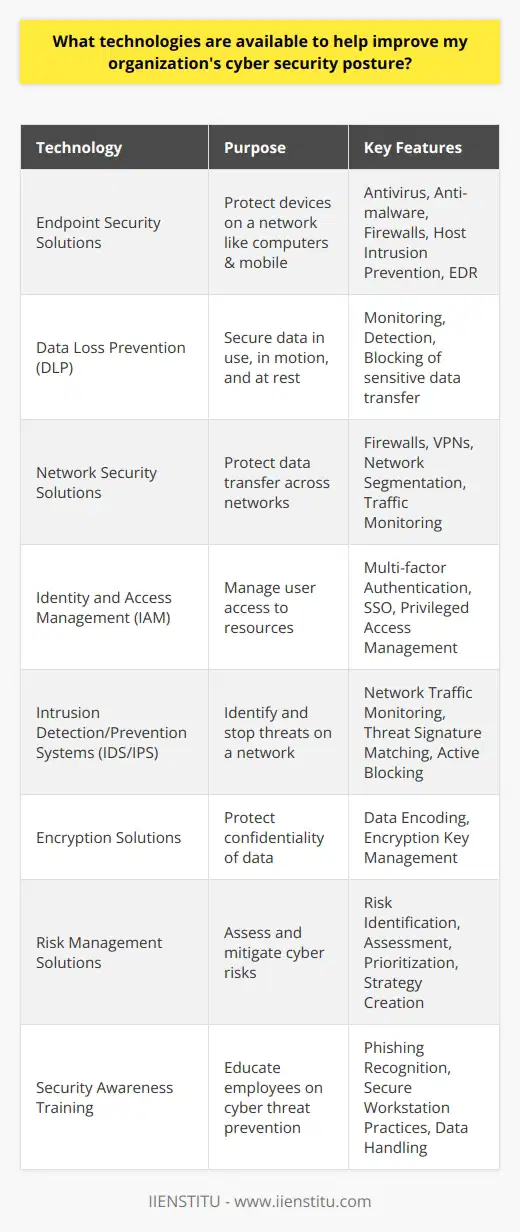
What is the role of encryption in cyber security?
Role of Encryption in Cyber Security
Protecting Sensitive Data
Encryption plays an essential role in cyber security as it safeguards sensitive data from unauthorized access. By employing algorithms and symmetric or asymmetric keys, data is transformed into an unreadable format, ensuring confidentiality and preventing cyber criminals from accessing valuable information.
Maintaining Privacy
In the modern digital era, maintaining privacy is of utmost importance. Encryption provides privacy by preventing data leaks and protecting personal information transmitted over communication networks, including emails, instant messaging, and social media platforms. This encryption enables individuals and organizations to communicate securely without divulging their sensitive data to potential attackers.
Integrity and Authentication
Another critical aspect of encryption in cyber security is ensuring data integrity and authentication. By utilizing digital signatures, encryption verifies the legitimacy of the sender and the integrity of the transmitted information. This process helps prevent cyber threats such as spoofing, phishing attacks, and unauthorized tampering of data.
Securing Communication Channels
Encryption is vital for securing communication channels, especially when using public networks and Wi-Fi connections. The use of encryption protocols, such as Secure Sockets Layer (SSL) and Transport Layer Security (TLS), ensures the secure exchange of data across networks, minimizing the risks associated with data interception and eavesdropping.
Enhancing Access Control
Encryption aids in enforcing robust access control policies. By employing encryption, businesses can limit the accessibility of data to authorized personnel only. This process reduces the risk of accidental or deliberate data breaches by ensuring that only qualified individuals can access and interpret critical data.
Conclusion
In conclusion, encryption is indispensable in the realm of cyber security. With the increasing number of cyber threats and high-profile data breaches, the use of encryption techniques is now more critical than ever. By providing confidentiality, privacy, integrity, authentication, and secure access control, encryption is the cornerstone of maintaining a robust and resilient cyber security framework.
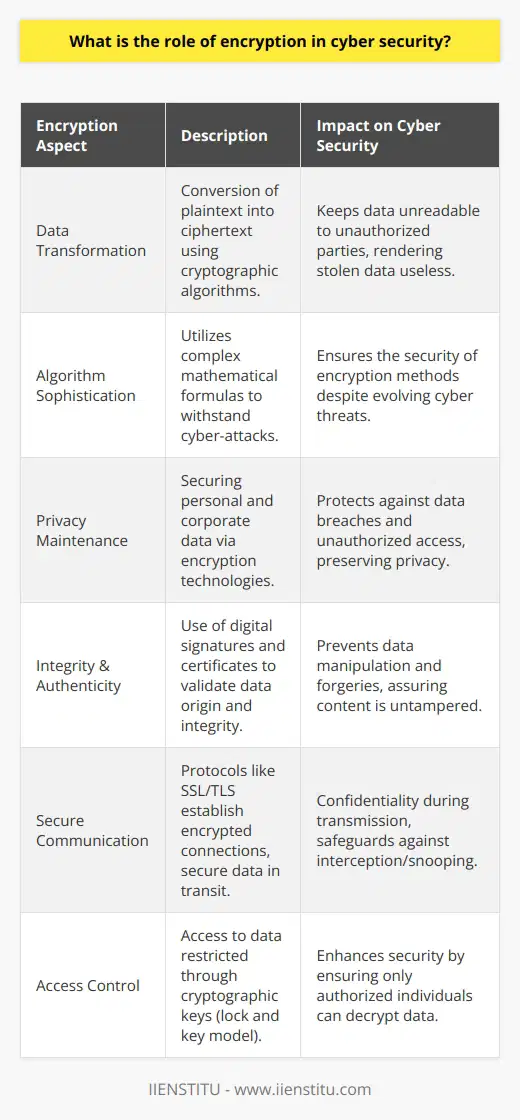
How can organizations effectively manage and mitigate cyber security threats?
Proactive Threat Identification
Organizations can effectively manage and mitigate cybersecurity threats by proactively identifying potential risks. Regularly conducting threat assessments and maintaining an updated inventory of assets, such as hardware, software, and data, enables organizations to foresee potential attack vectors and prioritize the most critical assets that require protection.
Training and Awareness
Regular training and awareness programs for employees can significantly contribute to an organization's cybersecurity posture. By teaching staff how to identify phishing emails, use strong passwords, and implementing two-factor authentication, organizations are better equipped to prevent unauthorized access to sensitive information.
Incident Response Plans
Establishing an incident response plan outlines specific actions and responsibilities for dealing with a security breach. This ensures that organizations can quickly detect, respond, and recover from cybersecurity incidents, thereby minimizing the potential damage and disruptions caused by an attack.
Collaboration and Information Sharing
Organizations can benefit from participating in threat intelligence sharing initiatives and collaborating with industry peers, law enforcement agencies, and regulatory bodies. Engaging in cybersecurity community forums and sharing resources, best practices, and emerging threat information fosters a proactive approach towards cybersecurity threats, ensuring an organization is not solely reliant on its internal resources.
Regular System Updates and Patch Management
Keeping software and systems up-to-date is critical in preventing security breaches. Regularly implementing security patches and updates reduces vulnerabilities that can be exploited by malicious actors. Consequently, organizations should establish a robust patch management process and maintain a schedule for system updates.
Implementation of Advanced Monitoring Tools
Leveraging advanced monitoring tools and security solutions, such as intrusion detection systems, antivirus software, and firewalls, can significantly enhance an organization's defense against cybersecurity threats. These tools monitor network activities for potential threats and anomalies, allowing organizations to detect and respond to cybersecurity incidents swiftly.
Continuous Evaluation and Improvement
Finally, organizations must continuously evaluate and improve their cybersecurity measures. Regular audits and penetration testing help identify potential weaknesses in security protocols and provide insights for implementing necessary changes. Keeping up with emerging technologies and trends in cybersecurity ensures that organizations maintain a strong and effective defense against evolving threats.
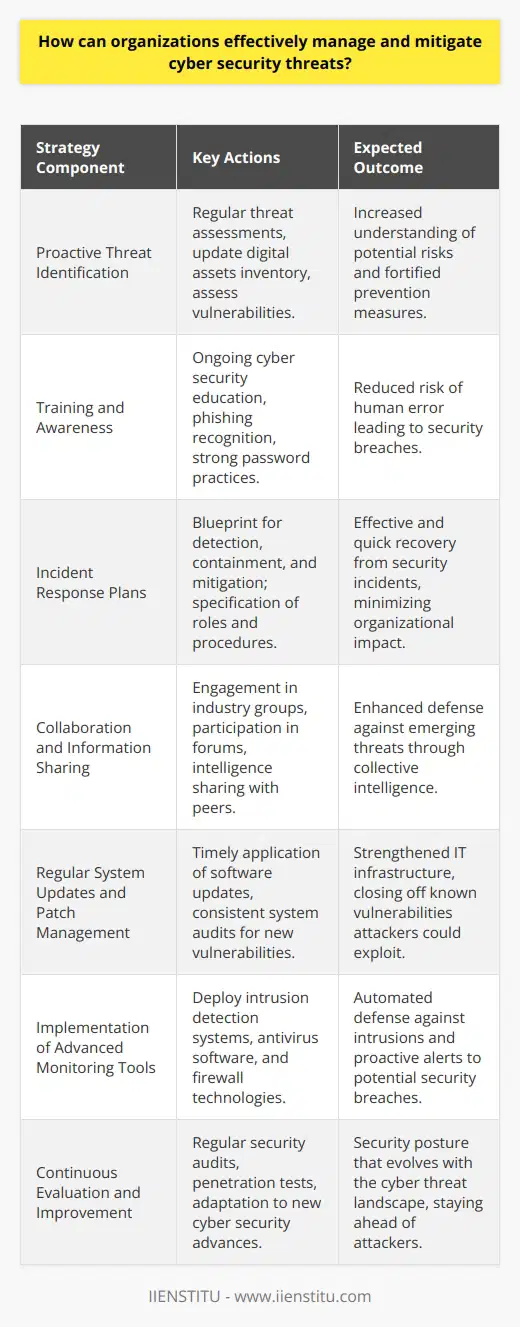
What is the significance of cyber security awareness and training among employees?
The Importance of Cyber Security Awareness
Cyber security awareness is a crucial aspect of maintaining a secure work environment in today's technologically advanced world. By providing employees with the knowledge and tools necessary to recognize potential cyber threats and protect information assets, organizations can minimize the risk of cyber-attacks and data breaches.
Effective Training for Employees
Training programs should be designed to educate employees about cyber security risks, policies, and preventive measures. This may include identifying phishing attempts, creating strong passwords, understanding the importance of software updates, and observing best practices for email and internet usage. Regular training ensures employees develop a strong understanding of these concepts, contributing to a culture of cyber safety.
Reducing Human Error
Human error is often the primary cause of successful cyber-attacks. By increasing cyber security awareness among employees, organizations can significantly reduce the likelihood of such errors occurring. For example, a well-informed employee would be more cautious when opening emails, reducing the chance of accidentally downloading malware or providing sensitive data to a cybercriminal.
Encouraging Reporting of Incidents
Establishing a sense of collective responsibility for the security of company data ensures that employees are more likely to report suspicious activity or potential data breaches. Encouragement from management and appropriate measures to maintain confidentiality can foster a culture of openness and collaboration in dealing with cyber threats.
Compliance with Regulatory Requirements
Beyond protecting valuable company data, organizations often have legal obligations to maintain a certain level of cyber security. Compliance with these regulations can be facilitated by a knowledgeable workforce that recognizes the significance of cyber security awareness and adheres to the policies and procedures in place.
Competitive Advantage and Reputation Management
A trained workforce that possesses a strong understanding of cyber security issues can keep customer data secure and protect the company from financial and reputational damage. A strong cyber security program may also provide a competitive advantage by instilling customer trust and ensuring compliance with industry-specific regulations.
In conclusion, investing in cyber security awareness and training for employees is essential for organizations to protect their information assets, maintain regulatory compliance, and manage their reputation. With targeted training and a focus on fostering a culture of cyber safety, organizations can help employees minimize human error and make more informed decisions when dealing with potential cyber threats.
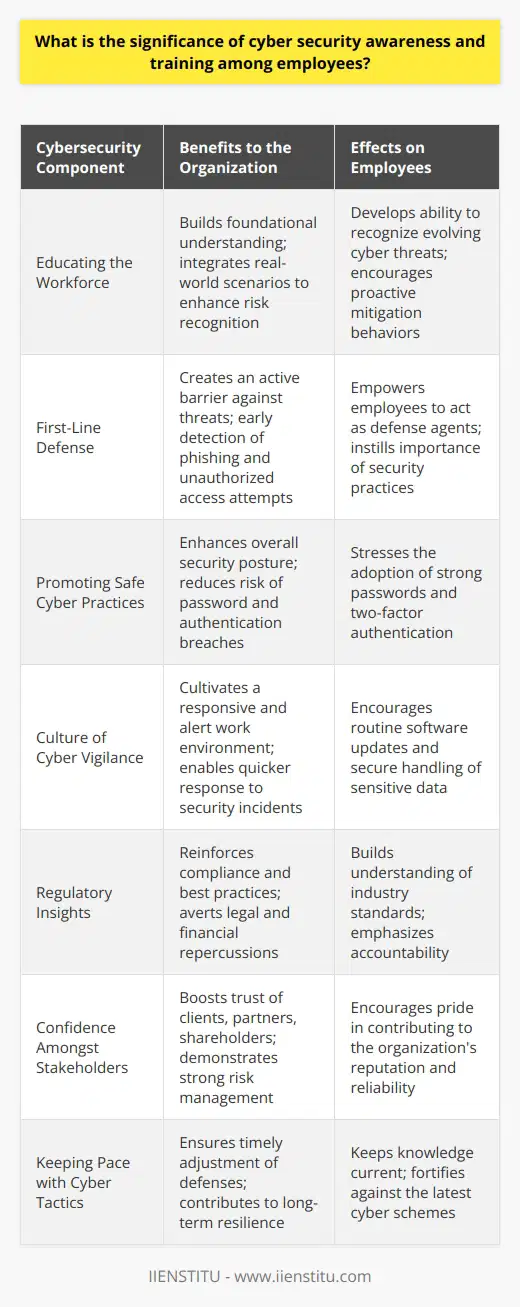
What is the relationship between cyber security and data privacy?
The Connection between Cyber Security and Data Privacy
Understanding the Concepts
In order to explore the relationship between cyber security and data privacy, we must first define the two concepts. Cyber security refers to the practice of protecting information systems, networks, and data from unauthorized access and potential harm. On the other hand, data privacy concerns the proper handling of data – specifically, ensuring that sensitive personal information remains confidential and is used only for its intended purpose.
Protecting Sensitive Data
A crucial aspect of data privacy is protecting sensitive personal data from unauthorized access or misuse. This is where cyber security plays a significant role; by preventing security breaches, cyber security helps safeguard data privacy. For instance, encryption techniques and secure authentication measures form a part of the cyber security framework aimed at protecting data from malicious actors.
Compliance with Regulations
Moreover, organizations must adhere to data protection laws and regulations, which often mandate strict cyber security measures. Thus, cyber security and data privacy are closely linked, as companies must employ robust security controls to comply with privacy requirements. For example, the European Union's General Data Protection Regulation (GDPR) requires organizations to implement appropriate technical and organizational measures to protect personal data.
Data Breach Consequences
The negative consequences of data breaches further underscore the relationship between cyber security and data privacy. A cyber attack resulting in unauthorized access to personal information not only causes damage to the organization's reputation but also has legal implications, as they may face penalties for failing to safeguard data privacy. Consequently, companies must invest in strong cyber security measures to prevent breaches and protect sensitive information.
Ensuring Trust and Privacy
In sum, the relationship between cyber security and data privacy is symbiotic in nature. Robust cyber security measures are essential for upholding data privacy standards and protecting sensitive information. Additionally, by preventing data breaches and ensuring compliance with privacy regulations, cyber security strengthens trust between organizations and their customers, ultimately fostering a more secure and private digital environment.
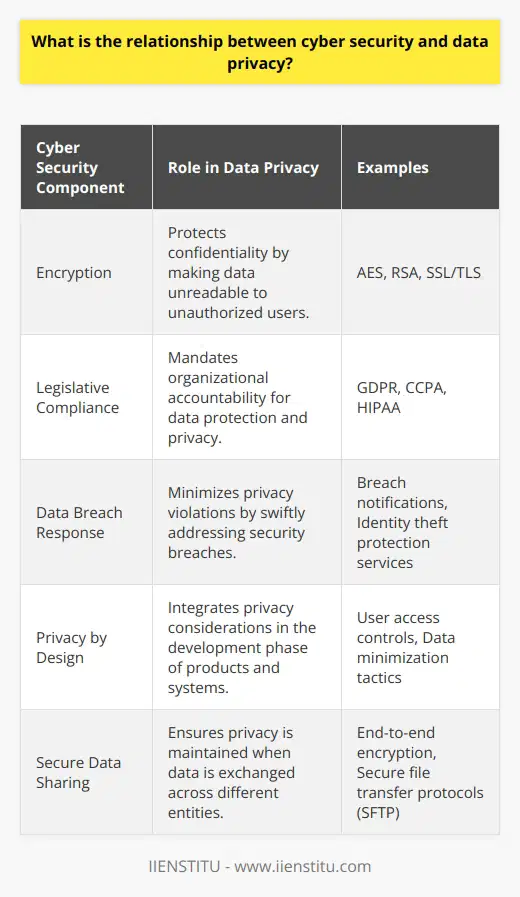
How do cyber security frameworks and standards contribute to an organization's overall security posture?
Understanding Frameworks and Standards
To comprehend how cyber security frameworks and standards contribute to an organization's overall security posture, it is crucial to first understand their role in shaping a company's security policies and practices. Cyber security frameworks offer a structured approach by providing guidelines for organizations to identify, protect, detect, respond, and recover from cyber threats. These serve as reference models that can be tailored to each organization's specific needs and risk tolerance levels.
Impact on Security Policies and Practices
The adoption of comprehensive cyber security standards supports the development and implementation of robust security policies, which are crucial to maintaining an organization's overall security posture. Through adhering to these best practices and recommendations, organizations can minimize vulnerabilities, protect sensitive information, and maintain their customers' trust. Furthermore, these standards facilitate continuous monitoring and improvements, helping organizations stay abreast of emerging threats and modify their security practices as needed.
Enhancing Risk Management
Implementing cyber security frameworks and standards considerably improves an organization's risk management capabilities. These instruments enable organizations to identify, assess, and prioritize risks associated with their information systems, ultimately guiding their decisions regarding resources allocation, mitigation strategies, and response plans. In addition, adopting a standardized approach enables cross-organizational communication about risks, fostering a proactive security culture within the company.
Ensuring Compliance
Adhering to noteworthy cyber security standards and frameworks such as ISO/IEC 27001, NIST Cybersecurity Framework, and CIS Critical Security Controls, helps organizations demonstrate their commitment to security and compliance with industry-specific regulations, such as GDPR or HIPAA. This not only bolsters their reputation and customers' trust, but also helps avoid penalties and legal consequences that may arise from non-compliance.
Promoting Incident Response Preparedness
Lastly, cyber security frameworks and standards play a crucial role in the development of effective incident response plans. By following a structured approach that outlines the necessary procedures and responsibilities, organizations are better equipped to identify, respond and mitigate the impact of cyber incidents, further strengthening their overall security posture.
In conclusion, adopting cyber security frameworks and standards offers numerous benefits for organizations, from improved risk management to regulatory compliance. By consistently following these guidelines and adapting them to unique organizational needs, companies can significantly enhance their overall security posture and resilience against cyber threats.

What are some common cyber security challenges faced by small and medium-sized enterprises (SMEs)?
Cybersecurity Challenges for Small and Medium-sized Enterprises
Limited Financial Resources
One major challenge small and medium-sized enterprises (SMEs) encounter is the limited financial resources available to invest in cybersecurity. This often results in inadequate protection and outdated security measures, which makes their systems more vulnerable to attacks.
Lack of Staff Expertise
SMEs often do not have dedicated cybersecurity staff, so their employees have limited expertise in security measures. This can lead to unintentional mistakes, such as falling for phishing attacks or not adhering to security best practices, thereby increasing the risk of a breach.
Complex Threat Landscape
The constantly evolving nature of cybersecurity threats adds to the challenges faced by SMEs. As threat actors continue to develop new methods of attack, businesses must continually adapt their security measures, which can be difficult for enterprises with limited resources and expertise.
Insufficient Awareness and Training
Many SMEs lack proper training and awareness programs for their employees. This deficiency increases the likelihood of employees falling for social engineering attacks or unintentionally exposing sensitive information, which can lead to data breaches or other security incidents.
Outdated Systems and Software
Due to limited budgets, SMEs often rely on outdated hardware and software. These legacy systems contain vulnerabilities that can be exploited by cybercriminals, and updates or patches for these systems may no longer be available, further increasing the risk of a breach or attack.
Third-Party Vulnerabilities
SMEs often work with third-party vendors or service providers, which can introduce new vulnerabilities. If a vendor's security is compromised, it can lead to negative consequences for their SME clients, such as exposure of sensitive data or damage to their reputation.
Balancing Security and Usability
Finally, SMEs must strike a balance between imposing strict security measures and maintaining ease of use for their employees. Overly restrictive policies may lead to decreased productivity, while overly lax measures can result in increased risk, presenting a delicate challenge for smaller enterprises.

What is the distinction between cyber security and information security?
Understanding the Key Differences
To understand the distinction between cyber security and information security, it is essential to define each concept separately. Cyber security refers to the practice of protecting computers, servers, mobile devices, electronic systems, networks, and data from digital attacks, damage, or unauthorized access. In contrast, information security broadly focuses on securing information and data – both physical and digital, in addition to protecting the confidentiality, integrity, and availability of information regardless of its format.
Variety of Threats
A crucial difference between cyber security and information security lies in the range of threats they seek to address. Cyber security is concerned primarily with external threats such as hacking, phishing, and malware attacks that exploit vulnerabilities in technology systems. On the other hand, information security also includes threats such as unauthorized disclosure, alteration, or destruction of information, which may arise from internal sources like employees or contractors.
Protective Measures
The protective measures employed in cyber security and information security differ accordingly. Cyber security solutions typically involve technical controls such as firewalls, intrusion prevention systems, and secure coding practices to prevent unauthorized access or damage to digital systems. Information security, however, adopts a combination of technical, administrative, and physical controls like encryption, personnel security, and access control, to ensure that information is kept secure both digitally and physically.
Interconnected Framework
Although cyber security and information security have their unique focuses and protective measures, they are also interconnected. Cyber security can be considered a sub-domain of information security, as it deals specifically with safeguarding digital data and resources. In this context, robust cyber security practices contribute to the overarching goal of information security, by securing the data in digital formats. Moreover, organizations must implement both cyber security and information security measures to maintain a comprehensive security posture, as the failure to address either would lead to vulnerabilities in the protection of information assets.
In conclusion, the distinction between cyber security and information security lies in their scope, threats, and corresponding protective measures. Cyber security focuses on safeguarding digital systems and data from external threats, while information security entails a broader approach, securing information – digital and physical, from various sources. Despite their differences, both domains play a significant role in ensuring the overall security of information assets within an organization.
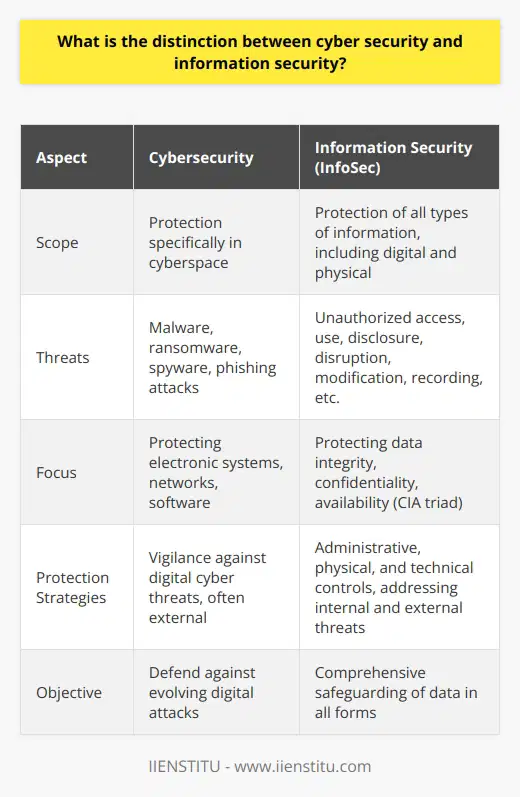
How do concepts like artificial intelligence and machine learning contribute to the ongoing advancement of cyber security?
Artificial Intelligence and Cyber Security
The rapid growth of technology has undoubtedly led to an increase in cyber threats. Consequently, the integration of artificial intelligence (AI) and machine learning (ML) has become crucial in mitigating these threats and enhancing the overall protection of sensitive information.
Machine Learning for Threat Identification
Machine learning employs algorithms that analyze massive data sets, enabling security analysts to identify patterns and trends. Through this analysis, ML contributes to the proactive identification of potential security threats, such as malware or phishing attacks. Furthermore, ML-based systems can adapt to new threats, making them more effective in combating increasingly sophisticated cyber-attacks.
AI-Driven Cyber Defense
Artificial intelligence uses algorithms to replicate human problem-solving capabilities, allowing AI-powered applications to undertake tasks such as monitoring entire networks and detecting anomalous behavior. These systems become 'intelligent' by learning from past data and previous incidents, increasing their accuracy and efficiency over time. As a result, AI-driven cyber defense tools can speed up response times and minimize potential damage caused by security breaches.
Enhancing Security Analysts' Efficiency
A synergy between human expertise and cutting-edge technology is necessary for effective cyber security. AI and ML can augment the capabilities of security analysts by providing actionable insights, automating repetitive tasks, and reducing the time spent on manual threat hunting. Consequently, AI and ML empower these experts to focus on strategic decision-making and root-cause analysis, leading to improved security outcomes.
Adaptive Authentication Solutions
AI and machine learning contribute to the development of robust authentication solutions, such as risk-based authentication (RBA). RBA systems leverage AI algorithms to analyze user behavior and calculate risk scores, dynamically adjusting authentication requirements based on these real-time assessments. Therefore, AI-powered authentication aids in preventing unauthorized access and reducing the risk of compromises in the security landscape.
In conclusion, artificial intelligence and machine learning play key roles in advancing cyber security by enhancing threat identification, fortifying cyber defenses, improving the efficiency of security analysts, and supporting adaptive authentication solutions. As cyber threats continue to evolve, the integration of AI and ML remains imperative in building robust and resilient cyber security infrastructures.
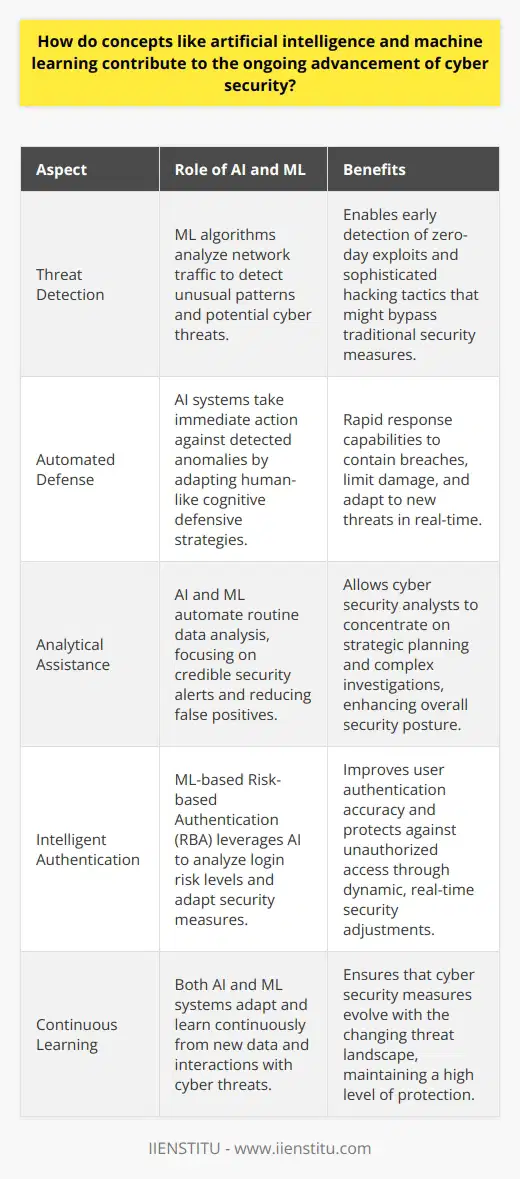
What role do governments and international organizations play in shaping global cyber security policies and practices?
Role of Governments in Cyber Security Policies
Governments play a crucial role in shaping global cyber security policies and practices. They establish national policies, enforce legislation, and allocate resources to protect critical infrastructures against cyber threats. In this capacity, governments work to standardize policies, promote information sharing, and build capacity to protect national security and promote economic growth.
Enforcement of Cybersecurity Regulations
One way governments help shape cyber security policies is by creating and enforcing laws and regulations. These policies often include data protection rules, industry-specific security requirements, and identification of critical infrastructure. Through regulatory oversight, governments ensure that businesses and organizations implement necessary security measures and maintain compliance with established norms.
International Cooperation and Collaboration
Governments also engage in international cooperation to enhance global cyber security. This includes participating in multilateral initiatives, such as the United Nations Group of Governmental Experts on Information Security and sharing cyber threat intelligence with other nations. Collaborative efforts serve as a platform for governments to discuss emerging threats, exchange best practices, and build trust among nations.
Promoting Research and Development
Investing in research and development is another critical aspect of the government's role in shaping global cyber security policies. By funding cutting-edge research and innovation, governments support the development of new technologies and strategies to strengthen cyber defense capabilities. Additionally, these investments can help drive economic growth in the technology sector.
International Organizations and Cyber Security
International organizations are instrumental in shaping global cyber security policies and practices. They provide forums for cooperation, exchange of best practices, and development of global standards.
Creation of Global Standards
International organizations such as the International Telecommunication Union (ITU) and the International Organization for Standardization (ISO) work to develop global cyber security standards. These standards provide a framework for countries and organizations to follow, promoting consistency and interoperability in cyber security practices.
Capacity Building and Awareness
Another key objective of international organizations is capacity building and promoting awareness of cyber security threats. Initiatives like the Global Cyber Security Capacity Centre (GCSCC), led by the World Bank, focus on improving the resilience of countries and organizations by providing practical guidance, training, and tools.
In conclusion, both governments and international organizations play a critical role in shaping global cyber security policies and practices by creating and enforcing regulations, sharing information and best practices, conducting research, and building capacity. Cooperation and collaboration between all stakeholders are required to effectively address complex cyber threats and protect global information infrastructure.
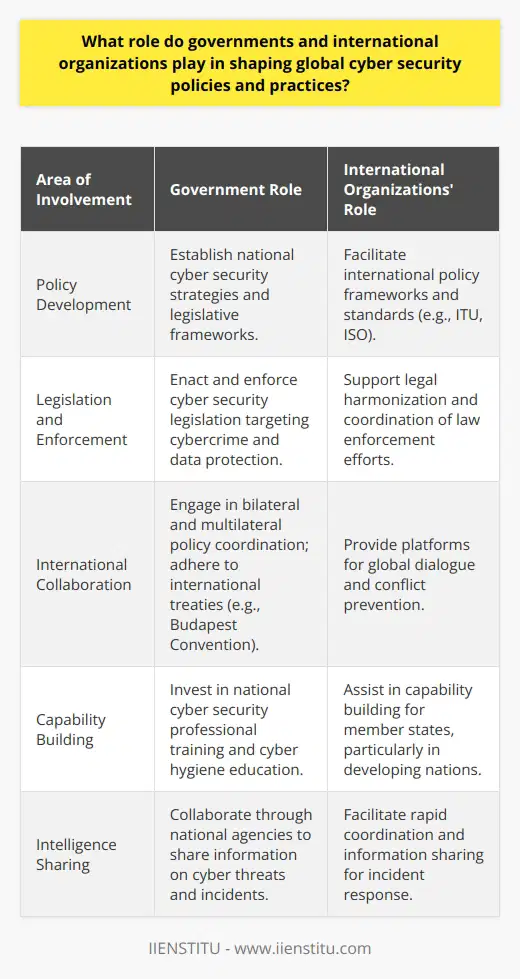
What is cyber security in simple words?
Understanding Cyber Security
Cyber security, in simple terms, is the practice of protecting internet-connected systems from potential threats. These systems include networks, devices, and data. The primary objective of cyber security is to safeguard digital assets, maintain confidentiality, and preserve the integrity and availability of data.
Importance of Cyber Security
With the increasing reliance on technology and the internet, cyber security has gained immense importance globally. As the digital landscape expands, so does the potential for cyber attacks. In a world where citizens, businesses, and governments rely heavily on digital platforms, ensuring the safety of information and systems is paramount.
Types of Cyber Incidents
Various types of cyber incidents target individuals and organizations. These incidents range from hacking attempts, malware infections, and phishing scams to distributed denial-of-service (DDoS) attacks. Cybercriminals exploit vulnerabilities in systems and user behavior to perpetrate their malicious activities, causing substantial financial and reputational damages.
Fundamental Cyber Security Measures
Effective cyber security comprises multiple strategies and measures. Some fundamental principles include securing networks through firewalls, strong user authentication, and regular software updates to patch vulnerabilities. Additional protection involves backing up data, restricting access to sensitive information, and raising awareness of potential cyber threats among users.
Importance of Collaboration
To strengthen global cyber defense, cooperation between governments, private sectors, and international organizations is essential. This collaboration involves sharing cyber threat intelligence, implementing best practices, and promoting innovative solutions to tackle the ever-evolving threat landscape.
In conclusion, cyber security is a crucial component in preserving the safety and integrity of the digital world. By understanding its importance and implementing security measures, individuals and organizations can contribute to a more secure digital environment.
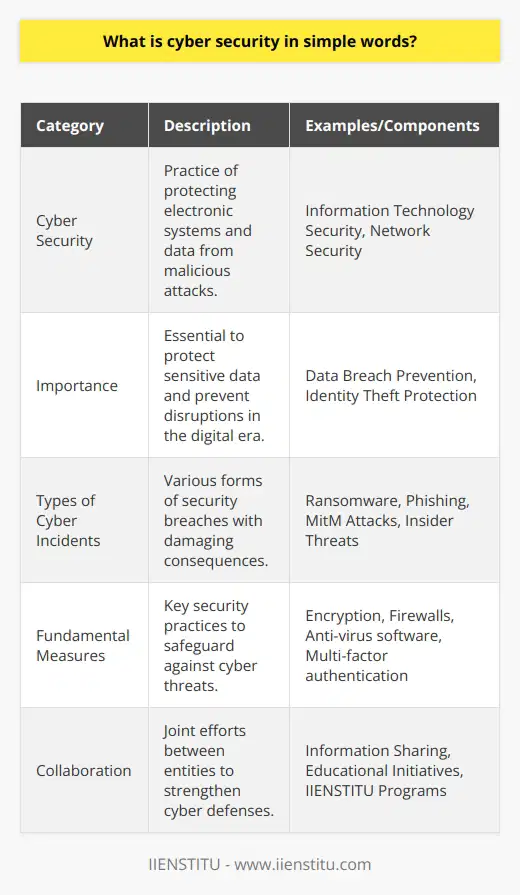
What are 3 benefits of cyber security?
Enhanced Data Protection
One significant benefit of cyber security is the enhanced protection of sensitive data. Cyber security measures effectively safeguard confidential information related to businesses, governments, and individuals, mitigating the risks of unauthorized access, corruption, or theft. Implementing robust cyber security programs ensures that critical data is secured against potential breaches, consequently preserving confidentiality, integrity, and availability.
Prevention of Cyber Threats
A fundamental advantage of cyber security is that it prevents various cyber threats, including malware, phishing, ransomware, and Distributed Denial of Service (DDoS) attacks. These malicious activities can cause severe damage to computer systems, networks, and software applications, resulting in substantial financial and reputational losses. By deploying advanced cyber security tools and techniques, potential cyber threats are detected and mitigated before they can inflict harm on the target systems.
Boosting Customer Trust and Confidence
Investing in effective cyber security measures not only guarantees the safety of a business's data but also bolsters customer trust and confidence. In today's digital age, customers expect their personal and financial information to be protected when interacting with organizations online. A strong cyber security posture demonstrates a company's commitment to secure its customers' data, thus enhancing the reputation and credibility of the business. This, in turn, fosters greater customer loyalty and promotes a more robust client base in the long run.

What are the 5 C's of cyber security?
**Understanding the 5 C's of Cyber Security**
The five C's of cyber security are a fundamental framework for any organization to follow in order to mitigate the risk of cyber threats in the digital age. They consist of Confidentiality, Compliance, Consistency, Control, and Communication.
**Confidentiality: Safeguarding Sensitive Information**
The first essential component is Confidentiality, which works to protect sensitive information from unauthorized access or disclosure. Ensuring that only authorized individuals can access this information is crucial to maintaining the trust of customers, partners, and stakeholders. One way to maintain confidentiality is by implementing strong encryption techniques and authentication measures.
**Compliance: Adhering to Regulations and Standards**
Compliance refers to the adherence to legal, regulatory, and organizational requirements governing information security. It is essential for organizations to stay up-to-date with the latest industry standards and guidelines, such as the General Data Protection Regulation (GDPR) and the Health Insurance Portability and Accountability Act (HIPAA). Non-compliance can result in severe fines or reputational damage.
**Consistency: Maintaining Regular Security Practices**
The third C, Consistency, emphasizes the importance of continuously updating and maintaining security practices within an organization. This includes regular reviews of security threats, periodic risk assessments, consistent training programs for employees, and the adoption of best practices for cyber security.
**Control: Implementing Robust Security Measures**
Control refers to the implementation of robust security measures to protect against threats, vulnerabilities, and other risks. Organizations should establish strong policies and procedures, such as access controls, incident response plans, and network segmentation, to minimize the risk of data breaches and other security incidents. Investing in cutting-edge technologies like artificial intelligence and machine learning can aid in detecting and preventing cyber threats.
**Communication: Fostering a Culture of Cyber Security Awareness**
Lastly, Communication is essential in creating a culture of cyber security awareness among all members of an organization. This involves regular training sessions, awareness campaigns, and effective communication channels to ensure everyone understands the potential risks and their roles in mitigating them. An informed and cooperative workforce significantly reduces the possibility of human error leading to security breaches.
In conclusion, the 5 C's of cyber security--Confidentiality, Compliance, Consistency, Control, and Communication--offer a comprehensive framework for organizations to address the ever-evolving landscape of cyber threats. Understanding and implementing these five principles will enable organizations to better protect their valuable data, assets, and reputation in the digital world.
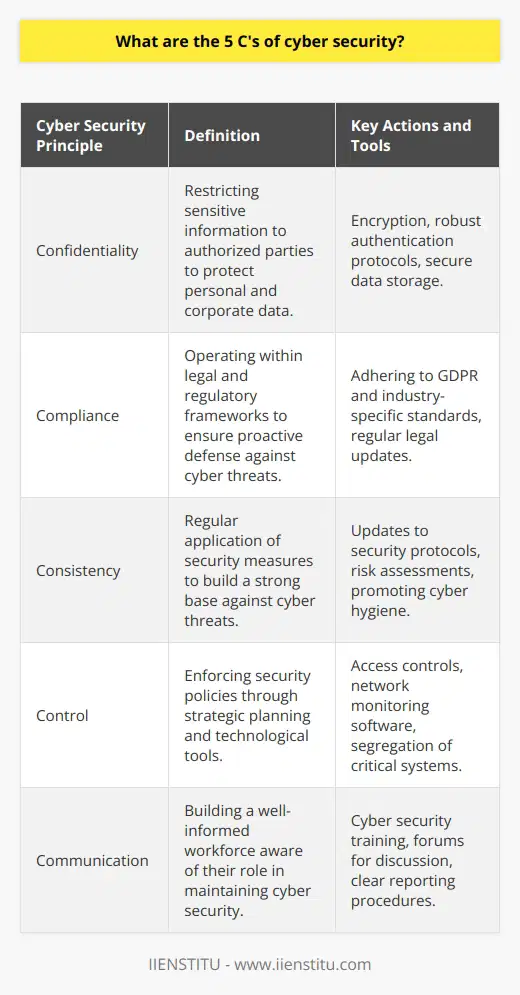
What is cyber security and why do we need it?
Understanding Cyber Security
Cyber security refers to the practice of protecting internet-connected systems from digital threats. These systems include hardware, software, and data from attacks, damage, or unauthorized access. It employs various techniques to safeguard data integrity, confidentiality, and availability, making the cyber world safer.
The Importance of Cyber Security
In our increasingly digital world, the need for cyber security becomes more urgent. It is fundamental to protect sensitive information, such as government, corporate, and personal data. Cyber threats can disrupt digital life, causing extensive damage. Without robust cyber security, vital data can be stolen, altered, or destroyed, leading to significant losses.
Threat Landscape
Hackers are continually seeking ways to exploit vulnerable systems, making the danger perpetual. They use malicious software or malware to penetrate networks and gain unauthorized access to data. Consequently, cyber security plays a pivotal role in combating these hostile activities.
Protection of Personal Information
We need cyber security to protect personal information. High-profile breaches show the dire repercussions of inadequate protection measures. A robust cyber security framework helps safeguard personal information, thus mitigating potential losses.
Guarding Business Interests
Businesses also benefit from cyber security. It protects their reputation and safeguards their intellectual property. Businesses face immense losses if their networks fall prey to cyber-attacks. Hence, cyber security measures are paramount, ensuring business continuity.
In conclusion, cyber security presents a robust defense against digital threats. Without it, the integrity of our cyberspace, personal information and business assets could be at risk. We need cyber security to create a safe online environment, enabling us to harness the full potential of digital technology without fear.
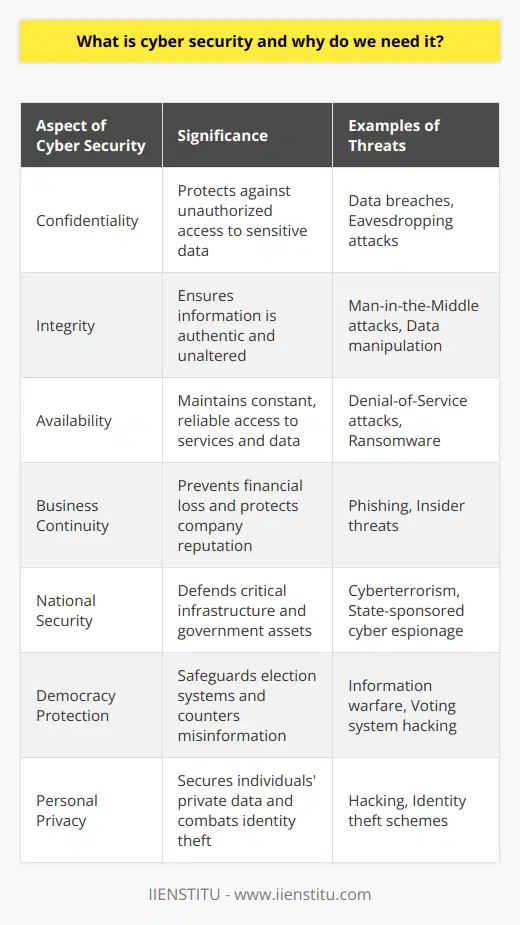
What are the 3 major types of cyber security?
Cyber Security Classification
The three major types of cybersecurity are Network Security, Application Security, and Information Security.
Network Security
Network security ensures the integrity of a network from intruders. It involves the deployment of policies, procedures, and applications to protect the network from unauthorized access, misuse, modification, or denial of service. Importantly, network security focuses on securing both the hardware and software functionalities of a network from potential threats.
Application Security
Application security involves measures taken at the application level to protect information from threats. These measures include using secure coding techniques, input validation checks, and software updates. Application security primarily seeks to prevent unauthorized access and data breaches. It ensures that an application functions correctly and securely over its life cycle, minimizing the potential vulnerabilities that a malicious party might exploit.
Information Security
Lastly, information security protects data integrity, availability and confidentiality. It encompasses the policies and procedures implemented to protect electronic, print, or other forms of confidential, private, and sensitive information. This type of security focuses on strategies to prevent unauthorized access, use, disclosure, disruption, modification, inspection, recording, or outright destruction of information.
In conclusion, the major types of cyber security - Network Security, Application Security, and Information Security - work in tandem to create a robust system, capable of thwarting cyber-attacks and preventing unauthorized access. Each type serves a significant function in protecting our virtual space in this increasingly digital age.
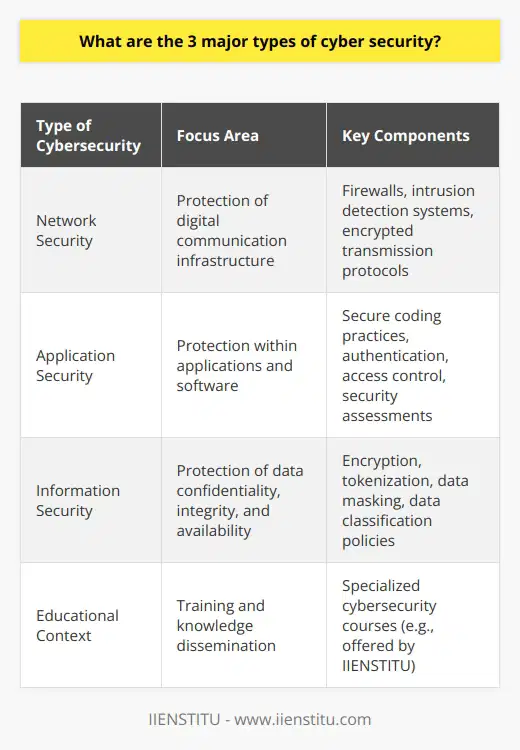
What role do governments and international organizations play in shaping global cyber security policies and practices?
Role of Government
The role of governments in shaping global cybersecurity policies and practices is significant. Governments set guidelines for all institutions within their jurisdiction. These guidelines include the adoption of secure software, protection measures, and response strategies to any cyber threats. They also incorporate the enforcement of privacy laws, which protect consumers' personal data. Besides, governments foster collaborations with other nations to enhance international cybersecurity standards.
International Organizations' Involvement
International organizations also contribute to global cybersecurity policies. Organizations such as the United Nations and the European Union, amongst others, promote cooperation among member countries to combat cyber threats. They make international commitments to enhance global digital security through policy formulation and implementation. This collaboration ensures the establishment of robust data protection measures that are globally acceptable.
Policy Development and Implementation
Furthermore, both governments and international bodies have a role in policy development and implementation. They enact laws that target cyber threats and impose penalties on cybercriminals. They further establish protocols that influence entities' cybersecurity practices, ensuring conformity to the policies.
Promoting Awareness
Also, they conduct wide-ranging awareness of cybersecurity risks. Governments and global organizations host seminars, workshops, and campaigns that help the public understand the importance of cyber-secure environments. This facilitation of knowledge sharing emphasizes the collective responsibility of ensuring global cybersecurity.
In conclusion, the involvement of government and international organizations in shaping global cybersecurity policies and practices is fundamental. Their responsibilities consist of policy development, legislative enforcement, and the promotion of international cooperation and public awareness. These efforts contribute to tackling cyber threats, providing a safer and more secure digital space for everyone.

